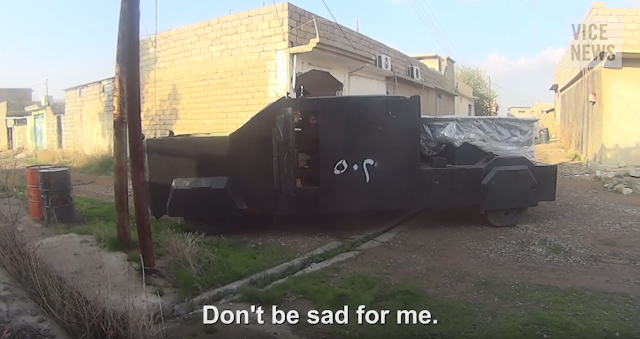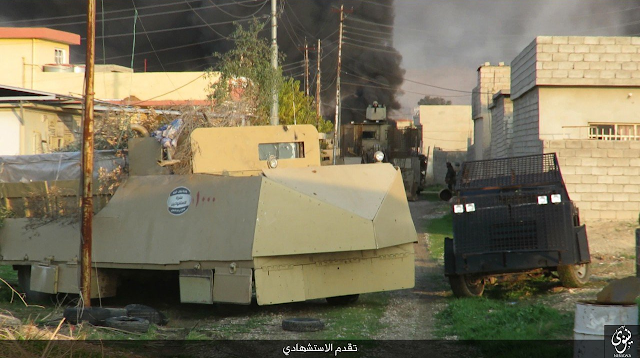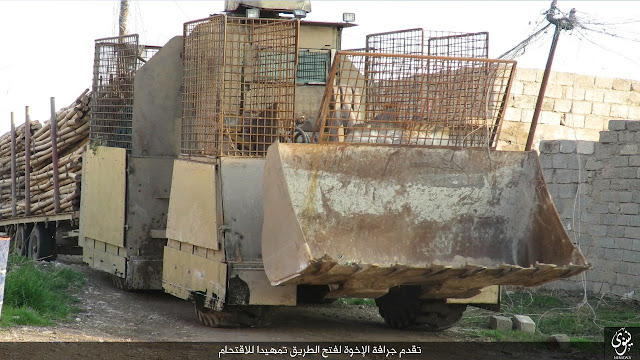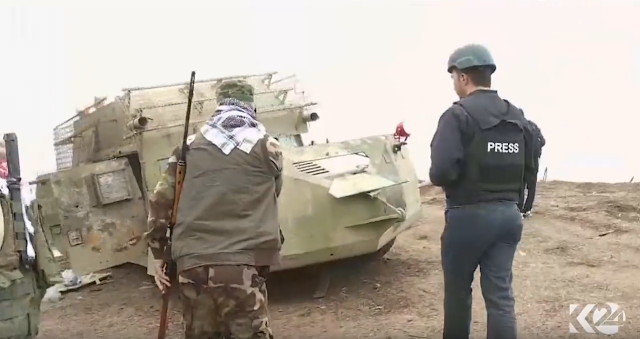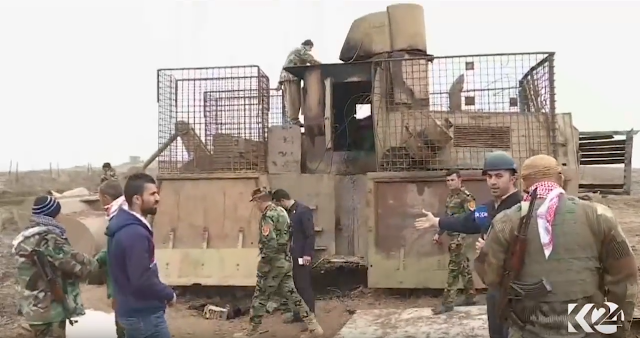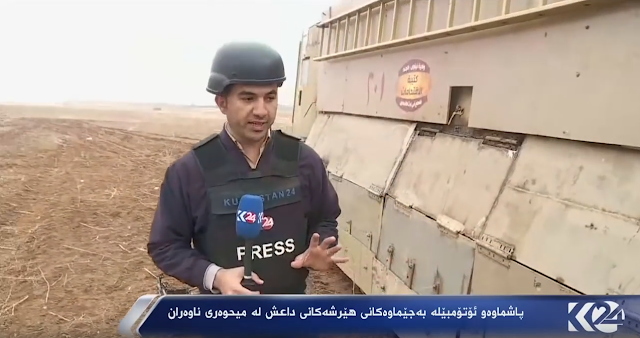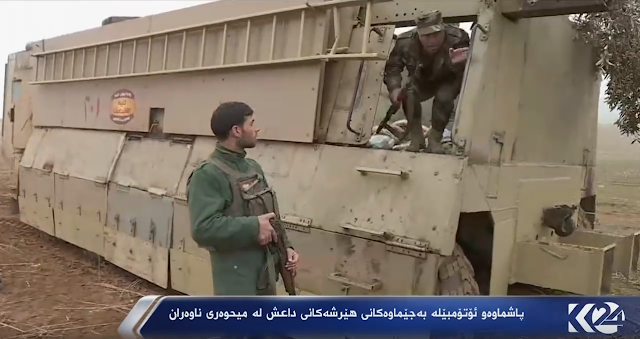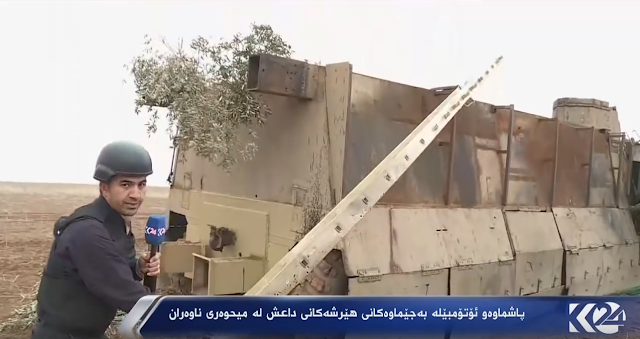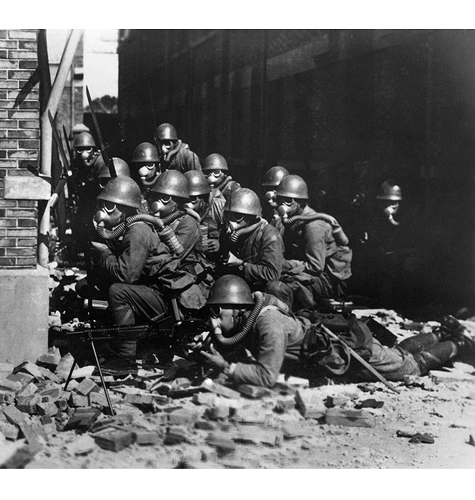New footage has emerged showing combat footage taken from the GoPro-cam of a fallen ISIS terrorist approximately 30 kilometers north of Mosul. Contrary to depictions by ISIS media outlets, their cooperation seems amateurish and moral is in absolute disarray.
The Islamic State going DIY, inside a DIY offensive
A video obtained by VICE News and uploaded on the 27th of April 2016 shows off spectacular footage taken by the headcam of an Islamic State fighter as he and his comrades fight their way to Peshmerga positions nearNaweran while under heavy enemy fire. The attack, which took place North of Mosul, clearly shows the panic and chaos that occur while on the battlefield, a completely different picture from the one presented in the videos published by the Islamic State’s media department, which almost exclusively shows well-trained fighters of the Islamic State defeating their opponents without any fear or regard to their own safety.
The footage offers a rare glimpse into the attacks that Peshmerga forces have been facing ever since the fall of Mosul, but now from the perspective of the Islamic State. This video doesn’t offer the whole story however, and because this attack has been documented extremely well by both the Islamic State and Peshmerga, we will attempt to break down the footage and images released by both parties and paint a clearer picture of this attack conducted by the Islamic State.
While VICE News claims the footage was taken in March this year, the depicted attack actually occurred in mid December 2015. As the Islamic State’s resulting defeat was widely reported on in Iraqi Kurdistan and abroad, it is not entirely clear how the supposed date got mixed up and suddenly ended up being March 2016.
Before going into detail about the actual battle itself, it is important to know the background of similar Islamic State offensives involving the use of armoured fighting vehicles (AFVs) conducted North of Mosul. Being the largest city located in the territory currently held by the Islamic State, Mosul is the capital of Wilayat (governorate) Ninawa. When it was overrun by the Islamic State, Mosul was overstocked with weaponry and vehicles intended to be used by the Iraqi Army and Police, which left all of their equipment behind before fleeing the city. While large parts of the huge arsenal left behind around Mosul were quickly distributed over the various fronts the Islamic State was fighting on, including Syria, some of AFVs that remained behind would later form the core of the Islamic State’s first armoured formations. Before the establishment of these formations, the use of AFVs by the Islamic State in Iraq was disorganised, and captured tanks would often be destroyed rather than operated simply because they weren’t deemed to be of use in the lightning attacks conducted by the Islamic State in Iraq. Only in the past year the limited amount of tanks in the Islamic State’s inventory have seen more widespread use in Iraq. While several U.S. M1 Abrams were captured intact, they were all deliberately demolished instead of put to use in offensives.
While these armoured formations were in the process of being set up, many of the vehicles were sent to workshops in Mosul for conversion into weapons platforms adapted to the Islamic State’s needs. Several of these vehicles have already been sighted in the past year, including two contraptions based on the BTS-5B armoured recovery vehicle (ARV), an otherwise useless vehicle for the Islamic State. The vehicles used in the December attacks on Peshmerga positions came from the same workshops, and their DIY armour certainly has the same improvisational tone to it as that seen on earlier Islamic State AFVs.
At least three armoured formations are believed to have been set up in Mosul, comprising the ‘al-Farouq Armoured Brigade’, which can be further divided into the 1st, 2nd, 3rd and possibly more battalions, the ‘Shield Battalion’, which has most of its vehicles painted in black, and the ‘Storming Battalion’. In addition to these three, a fourth formation called the ‘Suicide Battalion’ also operates a host of up-armoured vehicles as vehicle-borne improvised explosive devices (VBIEDs). But contrary to regular VBIED attacks so often used by the Islamic State, the ‘Suicide Battalion’ usually accompanies either of the three armoured formations as they are sent to the battlefield. VBIEDs of the ‘Suicide Battalion’ are to clear the way for the following armoured formations and can be seen as the Islamic State’s version of air support. During this attack, both the ‘Storming Battalion’ and the ‘Suicide Battalion’ took part.
Each battalion has its own seal. For example, the seal seen below is used by the 3rd al-Farouq Armoured Brigade. It reads: ولاية نينوى – الجند (?) لواء الفاروق المدرع الثالث – ‘Wilayat Ninawa – Soldiers (?) – al-Farouq Armoured Brigade – 3rd’. The second part of the Shahada: محمد رسول الله – ‘Muhammed is Allah’s prophet’ is seen on the right. This can sometimes be seen on Islamic State operated vehicles and is believed to be applied for decorative purposes only. While the seal is usually applied on vehicles in the form of a sticker, it is sometimes simply painted on vehicles, such as on this up-armoured M1114 (formerly) operated by the ‘Storming Battalion’.
While the Islamic State has proved to be more than capable of handling armour in Syria, its use of armoured fighting vehicles in Iraq leaves much to desire. At the core of this failure to properly field AFVs are the armoured formations based in Mosul, which apparently feel so comfortable knowing that every loss can simply be replaced by just another vehicle originally captured at Mosul when the city was overrun, that it keeps sending its AFVs against well-fortified Peshmerga positions to little effect. The first recorded example of such a large scale attack occurred in January 2015 near Shekhan, when several M1114s, Badger ILAVs, a M1117 ASV and the first battle bus took on a fortified Peshmerga position before getting obliterated. This loss did not deter the Islamic State from trying again however, as it would continue to send armoured formations (sometimes consisting of just a single vehicle) to the frontline, resulting in the same outcome every time. As the Peshmerga holds the high ground, and has had nearly two years to fortify their postions, even well-coordinated attacks are unlikely to succeed here, especially after they took delivery of MILAN anti-tank guided missiles (ATGMs).
This leads us to the attack depicted in the video released by VICE News, one in the series that ended up resulting in high losses for the Islamic State and literally no gains made. The attack, believed to have taken place on the 16th of December 2015, saw fighters of the Islamic State trying to breach Peshmerga positions on several locations, resulting in the death of at least seventy fighters. More about this offensive can be read here. Although the offensive resulted in failure, the media department of Wilayat Ninawa bravely decided to publish the images shot before and during the offensive anyway. Ironically, these images were uploaded only after the TV channel ‘Kurdistan24’ had already shown footage of the result of the attack, including the still burning remains of the vehicles after the attack. The photo report released by the Islamic State a day later would show these exact same vehicles still in pristine condition hours before the attack. Nonetheless, the photo report gives us a great insight into the development of the attack and even reveals the names of the fighters involved.
The footage released by VICE News starts at 0:46, when the cameraman (Abu Ridhwan) records the final words of a suicide bomber, a member of the ‘Suicide Battalion’, before he attempts to blow himself up. He is accompanied by two younger fighters, which were not seen during the attack and likely didn’t participate. Although the presence of a camera hints that this video was to be released by the media department of Wilayat Ninawa if the attack would have succeeded or the cameraman would have survived, the presence of two children next to the suicide bomber leave a rather awkward impression, and would likely not have made the final cut.
The next shot, starting at 1:11, shows the suicide bomber before heading off to his target. He says his final words, one of which can be seen in the image below. The load of explosives is mounted at the back of his vehicle, and can be seen covered by a plastic tarp here. His up-armoured vehicle has been serialled ‘502’, which is common practice with VBIEDs of the ‘Suicide Battalion’.
A total of four VBIEDs would be used during this offensive, two of which can be seen below. The monstrosity on the left is clearly marked as a vehicle of the ‘Suicide Battalion’, carrying the serial ‘1000’. This vehicle appears well-armoured, with thick panels installed on the front and side of the vehicle to protect its wheels. Its deadly payload, also covered by a plastic tarp, can be seen on the back of the vehicle, which has been ‘camouflaged’ by the addition of several tree branches. The black painted VBIED on the right received slat armour on the front of the vehicle in addition to plated armour elsewhere. Four headlights have been mounted somewhat clumsily on the front row of the slat armour. In fact, although attacking in broad daylight, almost all vehicles can be seen with headlights, likely because movement to the operational zone happens by night. An armoured bulldozer can be seen behind the two VBIEDs, which would also feature in the attack.
Next at 1:31 is the departure of Abu Ridhwan’s up-armoured M1114, which has been converted to hold an armoured cabin over its original body. This cabin is large enough to hold three occupants, their weaponry and ammunition and a pintle-mounted machine gun. Two of such converted vehicles would take part in the attack. Although the other vehicle boasts a Chinese 12.7mm W85 heavy machine gun, the vehicle of Abu Ridhwan is not equipped with a heavy machine gun, and has to do with a German 7.62mm MG3, which is manned by Abu Hajaar, seen on the right in the image below. Abu Ridhwan’s M1114 is crewed by a total of five people including: Khattab (Driver), Abu Hajaar (MG3 gunner), Abu Abdullah (RPG gunner), Abu Ridhwan (Commander, reloader and 7.62mm ‘al-Quds’ RPK gunner) and Walid (AKM gunner) occupying the front seat.
As an armoured panel blocks our view of the front seats, the faces of Khattab and Walid aren’t seen throughout the video. Of Abu Hajaar, Abu Abdullah and Abu Ridhwan, only the latter appears to have any kind of combat experience. Both Abu Hajaar and Abu Abdullah’s performance is rather unimpressive, and in a certain sense almost comedic.
The new cabin of the M1114 was well protected by its slat armour and additional metal plating in combined with the vehicle’s original armour. To allow the cabin crew of three to sit during the ride to the battlefield, the cabin has been covered with foam and seatbelts were installed.
The other M1114 almost identical to that of Abu Ridhwan but armed with a Chinese 12.7mm W85. This vehicle is not armed with slat armour however, and relies on its orginal armour and the somewhat peculiar additional metal plating. An opening has been made in the metal plating at the front of the vehicle, the purpose of which is unknown however.
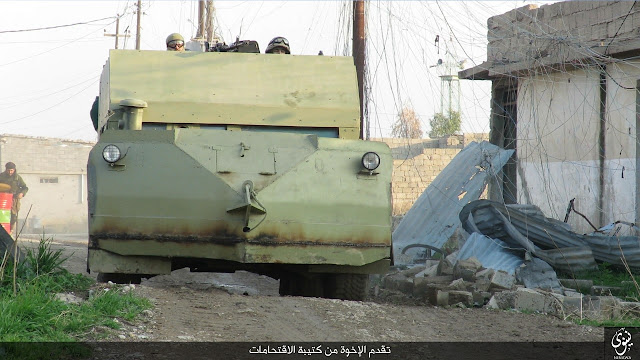
At 1:43 Abu Ridhwan’s GoPro records some of the unguided rockets that would be fired in advance of their attack. The impressive amount of 45 ‘Fath’ unguided rockets (albeit with less impressive accuracy and destruction power) supplemented by a single 120mm mortar would be used to pound Peshmerga positions.
1:52 begins with the ‘Storming Battalion’s’ march to the combat zone. It is likely that all four VBIEDs had already made their way to their targets by this time, of which at least two were destroyed before reaching their targets. Abu Ridhwan’s vehicle is encircled in the second image below.
Apart from the two converted M1114s, the ‘Storming Battalion’ used several other converted vehicles in this battle, including another M1114, one U.S. M1117 ASV, one up-armoured bulldozer equipped with a heavy machine gun cupola, one up-armoured truck with an armoured cabin and a heavy machine gun cupola and several technicals with various amounts of DIY armour equipped with a range of different guns.
The battalion first starts to take fire at 2:00, when an RPG shot bounces off the ground slightly in front the other up-armoured M1114. Only seconds later, Abu Ridhwan optimistically begins to engage the entrenched Peshmerga with his 7.62mm al-Quds light machine gun from afar. After he’s emptied his first magazine (and struggles to find a new one), Abu Hajaar then begins engaging the enemy with his 7.62mm MG3. This is where the first problems for the crew start to arise. As RPGs are designed to be operated right-handed, Abu Abdullah is standing on the right side of armoured cabin, with Abu Hajaar on the left and Abu Ridhwan in the back. Abu Hajaar’s MG3 empties its belt links to the right side however, resulting in Abu Abdullah getting hit by these hot belt links flying through the cabin. He attempts to warn Abu Hajaar of this effect, which can only be stopped if he ceases firing the MG3 or turns it sideways, due to which he can no longer aim.
As the vehicle is closing in on Peshermerga positions, Abu Ridhwan and Abu Hajaar begin to engage a position on their left side. Abu Hajaar’s MG3 is leaning on a thin piece of metal of the front of the cabin, which due to the blocking unfolded bipod gives little support to the MG3. Unsurprisingly given the poor support of the gun and bad handling by Abu Hajaar, his MG3 then falls off the railing and begins firing into the plating just below, causing bullets to fly through the cabin. Abu Ridhwan and Abu Abdullah then begin screaming ‘Abu Hajaar’ again, who continues firing in the meantime.
This is also when we receive the first glimpse of Abu Abdullah’s RPG-7, for which he used both 85mm PG-7V anti-tank grenades and 40mm OG-7V fragmentation grenades for use against personnel. Indeed, all occupants are extremely well armed and equipped, carrying several magazines and reloads each. Furthermore, plenty of food and water is stored in the vehicle.
The next shot at 2:30 shows the up-armoured behemoth and the other up-armoured M1114 that was nearly hit only a minute before. One RPG gunner stands in the armoured cabin of the truck to aim his next shot.
This is also when Abu Abdullah has just fired his first OG-7V and asks for a reload, but forgets to mention whether he wants an AP or fragmentation round next and then begins looking towards the enemy positions again. Abu Ridhwan randomly grabs a round and gives it to Abu Abdullah, which fails to notice a round is being handed to him, leading to further frustation from Abu Ridhwan.
Abu Abdullah then makes the crucial mistake of asking Abu Hajaar to cover him while reloading, which unsurprisingly leads to another stream of hot shell casings hitting Abu Abdullah, which then bursts into anger with Abu Hajaar for not looking out.
Sensing the impending danger of Abu Abdullah firing off an RPG grenade, Abu Ridhwan warns him to watch out, followed by an instruction to change his position not to allow the backblast to fly into the small compartment. While he does change his position, the adjustment is not enough and the subsequent backblast damages Abu Ridhwan’s camera.
The next shot shows one of the other up-armoured M1114s having been hit, disabled and set on fire, Abu Hajaar then continues firing towards the enemy positions and manages to fire into the cabin for a second time.
A specially modified Zavasta M70 is then used to fire rifle grenades towards Peshermerga positions as the crew gets closer to their entrenched position. The first two rifle grenades are deemed to be too tight a fit by Abu Abdullah, a result of their crude DIY design, and while the third fits more readily, the slow fuse won’t ignite. In the end, Abu Ridhwan attempts to light it again himself, but it seems doubtful the rifle grenade will have functioned properly.
In the theme of the 16th of December clearly not being Abu Hajaar’s day, he almost gets hit by Abu Ridhwan’s rifle grenade as he fires it towards the Peshmerga.
Abu Ridhwan and Abu Abdullah then have trouble agreeing on what RPG round to take, with Abu Abdullah insisting he needs a fragmentation round. Abu Ridhwan then gives him an AT round, which he attempts to launch with the safety cap still on. The vehicle has meanwhile stopped driving (possibly because Khattab the driver has been shot), providing an easy target for the Peshmerga forces.
Indeed, before having the chance to fire his RPG, the vehicle gets hit by (presumably) an RPG itself, and if the driver was still alive until this point, moments later he certainly is not. While escaping the vehicle through the back, a fourth person can be seen laying on the ground, likely Walid which sat next to Khattab. Abu Ridhwan continues firing on the Peshmerga with his al-Quds light machine gun, taking cover behind the now useless M1114.
A disorganised retreat ensues. While Abu Abdullah and Abu Hajaar make their way across the open fields by rolling sideways through the dirt in order to maintain a low profile, Abu Ridhwan makes a run for it and is shot after stopping for a moment. The four remaining fighters attempt to return fire for a while, and Abu Abdullah is seen running back to the M1114 whilst firing at random in a suicidal last ditch effort to make something of the situation. Abu Ridhwan and continues retreating (this time adopting the sideways roll employed by his fellow fighters) but is ultimately killed nonetheless.
The footage shot by Kurdistan24 shows the aftermath of the attack, including much of the destroyed armour after having being towed closer to Peshmerga positions by an armoured bulldozer. First off is one of the VBIEDs, which has been disabled before being able to detonate its deadly load. More interesting however is the vehicle parked behind this VBIED, as this up-armoured M1114 is in fact the vehicle of Abu Ridhwan.
Also seen again is the armoured bulldozer, which apparently got stuck in the ditch that would have prevented vehicles of the Islamic State from ever reaching Peshmerga positions in the first place. The armoured cabin of the bulldozer appears to have been hit, after which the vehicle was rendered inoperable or simply abandoned.
Although not seen during the attack itself, the remains of a U.S. M1117 Armoured Security Vehicle (ASV) can also be seen. This vehicle, armed with a single 40mm Mk.19 grenade launcher and 12.7mm M2 Browning heavy machine gun, has been completely obliterated by Peshmerga fire or perhaps an airstrike, tearing the hull to shreds and leaving little more than a carcass behind. The remains of another unidentified vehicle can be seen shortly after.
Another truck-based behemoth used during the assault (visible in VICE’s video at 2:31) can be seen below, carrying the serial number ‘201’ and the seal of ‘Storming Battalion’. Note the ladders mounted on the side of the vehicle, likely there for scaling the trenches or climbing up fortified Peshmerga positions.
In the end, the attack paints a clear picture of the result any poorly planned offensive against a dug in adversary will attain. No amount of DIY monstrosities or VBIEDs will make up for this strategic disadvantage, and the stumbling and fumbling of the unexperienced Islamic State fighters before their inevitable death should be a clear sign these tactics will accomplish little. For the time being, it appears the Islamic State remains capable of producing more AFVs and willing to sacrifice lives to keep up such pointless assaults, and thus the Peshmerga front North of Mosul is likely to continue to be the scene of fierce fighting and ever more grotesque DIY creations.
from: https://www.almasdarnews.com/article/combat-cam-isis-fighters-panic-film-final-moments/
Pubblicazione gratuita di libera circolazione. Gli Autori non sono soggetti a compensi per le loro opere. Se per errore qualche testo o immagine fosse pubblicato in via inappropriata chiediamo agli Autori di segnalarci il fatto è provvederemo alla sua cancellazione dal sito





